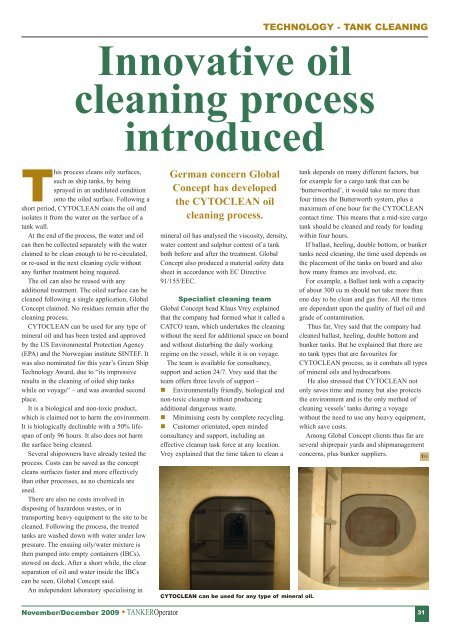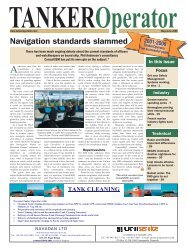Features: - Tanker Operator
Features: - Tanker Operator
Features: - Tanker Operator
Create successful ePaper yourself
Turn your PDF publications into a flip-book with our unique Google optimized e-Paper software.
TECHNOLOGY - TANK CLEANING<br />
Innovative oil<br />
cleaning process<br />
introduced<br />
This process cleans oily surfaces,<br />
such as ship tanks, by being<br />
sprayed in an undiluted condition<br />
onto the oiled surface. Following a<br />
short period, CYTOCLEAN coats the oil and<br />
isolates it from the water on the surface of a<br />
tank wall.<br />
At the end of the process, the water and oil<br />
can then be collected separately with the water<br />
claimed to be clean enough to be re-circulated,<br />
or re-used in the next cleaning cycle without<br />
any further treatment being required.<br />
The oil can also be reused with any<br />
additional treatment. The oiled surface can be<br />
cleaned following a single application, Global<br />
Concept claimed. No residues remain after the<br />
cleaning process.<br />
CYTOCLEAN can be used for any type of<br />
mineral oil and has been tested and approved<br />
by the US Environmental Protection Agency<br />
(EPA) and the Norwegian institute SINTEF. It<br />
was also nominated for this year’s Green Ship<br />
Technology Award, due to “its impressive<br />
results in the cleaning of oiled ship tanks<br />
while on voyage” – and was awarded second<br />
place.<br />
It is a biological and non-toxic product,<br />
which is claimed not to harm the environment.<br />
It is biologically declinable with a 50% lifespan<br />
of only 96 hours. It also does not harm<br />
the surface being cleaned.<br />
Several shipowners have already tested the<br />
process. Costs can be saved as the concept<br />
cleans surfaces faster and more effectively<br />
than other processes, as no chemicals are<br />
used.<br />
There are also no costs involved in<br />
disposing of hazardous wastes, or in<br />
transporting heavy equipment to the site to be<br />
cleaned. Following the process, the treated<br />
tanks are washed down with water under low<br />
pressure. The ensuing oily/water mixture is<br />
then pumped into empty containers (IBCs),<br />
stowed on deck. After a short while, the clear<br />
separation of oil and water inside the IBCs<br />
can be seen, Global Concept said.<br />
An independent laboratory specialising in<br />
German concern Global<br />
Concept has developed<br />
the CYTOCLEA oil<br />
cleaning process.<br />
mineral oil has analysed the viscosity, density,<br />
water content and sulphur content of a tank<br />
both before and after the treatment. Global<br />
Concept also produced a material safety data<br />
sheet in accordance with EC Directive<br />
91/155/EEC.<br />
Specialist cleaning team<br />
Global Concept head Klaus Vrey explained<br />
that the company had formed what it called a<br />
CATCO team, which undertakes the cleaning<br />
without the need for additional space on board<br />
and without disturbing the daily working<br />
regime on the vessel, while it is on voyage.<br />
The team is available for consultancy,<br />
support and action 24/7. Vrey said that the<br />
team offers three levels of support -<br />
Environmentally friendly, biological and<br />
non-toxic cleanup without producing<br />
additional dangerous waste.<br />
Minimising costs by complete recycling.<br />
Customer orientated, open minded<br />
consultancy and support, including an<br />
effective cleanup task force at any location.<br />
Vrey explained that the time taken to clean a<br />
CYTOCLEAN can be used for any type of mineral oil.<br />
tank depends on many different factors, but<br />
for example for a cargo tank that can be<br />
‘butterworthed’, it would take no more than<br />
four times the Butterworth system, plus a<br />
maximum of one hour for the CYTOCLEAN<br />
contact time. This means that a mid-size cargo<br />
tank should be cleaned and ready for loading<br />
within four hours.<br />
If ballast, heeling, double bottom, or bunker<br />
tanks need cleaning, the time used depends on<br />
the placement of the tanks on board and also<br />
how many frames are involved, etc.<br />
For example, a Ballast tank with a capacity<br />
of about 300 cu m should not take more than<br />
one day to be clean and gas free. All the times<br />
are dependant upon the quality of fuel oil and<br />
grade of contamination.<br />
Thus far, Vrey said that the company had<br />
cleaned ballast, heeling, double bottom and<br />
bunker tanks. But he explained that there are<br />
no tank types that are favourites for<br />
CYTOCLEAN process, as it combats all types<br />
of mineral oils and hydrocarbons.<br />
He also stressed that CYTOCLEAN not<br />
only saves time and money but also protects<br />
the environment and is the only method of<br />
cleaning vessels’ tanks during a voyage<br />
without the need to use any heavy equipment,<br />
which save costs.<br />
Among Global Concept clients thus far are<br />
several shiprepair yards and shipmanagement<br />
concerns, plus bunker suppliers.<br />
TO<br />
November/December 2009 TANKER<strong>Operator</strong> 31

















